
Copyright
Hessonite Garnets and Other Fine Minerals from the Jeffrey Mine, Québec
By Sylvain Roy
The Jeffrey Mine at Asbestos, Québec, Canada has been in operation for more than a century. It is known to collectors for having produced mineral specimens of exceptional and aesthetic quality, such as the gem quality variety of grossular called hessonite that was discovered recently. Some of the best specimens have been preserved at the Canadian Museum of Nature and by a number of private collectors. This article serves merely as an introduction to the mine, its history and some of the minerals found there. Included are photographs of some of the exceptional hessonite garnet specimens I recently found. Collectors who wish to learn more about the mine and its fabulous minerals may wish to read the article by J.D. Grice and R. Williams published in the April-March 1979 issue of the Mineralogical Record.
The Jeffrey Mine is mostly known for producing asbestos, which was used previously for insulation. It has produced asbestos for more than a century. It was Evan Williams, a Welsh slater, who first discovered the asbestos deposits in 1880. Following the discovery, Williams persuaded a wealthy farmer, W.A. Jeffrey (whom the mine is named after), to advance the funds necessary for him to develop the asbestos layer, which was located on a hill. Extraction of the asbestos began in 1881.
In 1895, because of financial problems, W.A. Jeffrey yielded his interests to a group of associates, who in turn formed the Asbestos and Asbestic Company in 1897. In 1916 the mine became the property of the Manville Asbestos Company, which was reorganized two years later under the new corporate name of Canadian John-Manville Company, Limited. This company has mined the property since then.
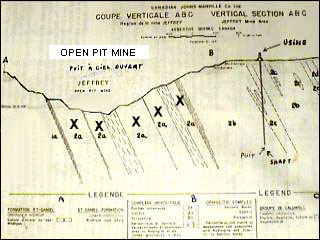
Figure 1: Vertical section of the Jeffrey Mine. The ophiolitic zone complexes are marked as X.
|
Today, nothing any more remains of the original hill because of open pit mining. The pit is more than 0.7 km in diameter and approximately 0.45 km of depth. Figure 1 shows a vertical section of the mine. On close inspection, one notices an ophiolitic zone complex (marked as X). This zone contains rocks such as peridotite, dunite, unquestionable pyroxenite, gabbro and intrusive rocks in association. The two types of rock of interest the mine owners are peridotite and dunite, which are serpentinized by fibrous chrysotile veins. But for collectors like myself, the intrusive rocks are the most important and draw attention whenever we are given permission to access the mine. The term "intrusive rocks" indicates the particular formation of rock which collectors look for when they search for minerals at the Jeffrey Mine.
The intrusive rocks form many irregular masses resembling "filons" (dykes) and their composition varies. They are granites that contain diorite, albite and sometimes the very rare rodhingite. Where these filons (dykes) contact the serpentinized rocks, a zone formed by hydrothermal deterioration occurs. It is here where the famous grossular garnets (which includes hessonite), diopside, prehnite, and vesuvianite are found and forged the reputation of the Jeffrey Mine as a world class mineral locality (see Figures 2-4, and 5-6).
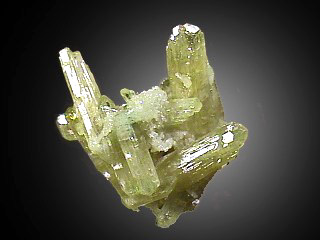
Figure 2: Vesuvianite. Some of the crystals in this specimen reach 2.5 cm in length. This specimen was recovered in 2001. Photo by Sylvain Roy.
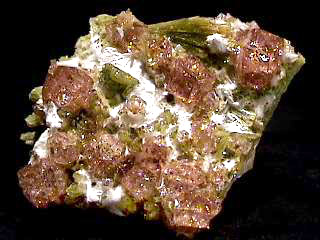
Figure 3: Gemmy pink hessonite crystals up to 8 mm in diameter on crystals of pectolite (white) and diopside (green). This specimen was found in the summer of 1998. Photo by Sylvain Roy.
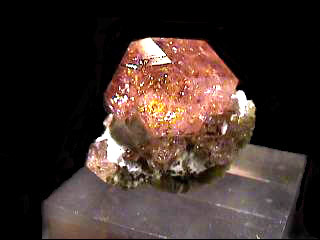
Figure 4: Another perfect gemmy crystal of pink hessonite size 16 mm on pectolite and diopside. Photo by Sylvain Roy.
|
More than sixty different minerals have been found at the mine. Some of these minerals are listed in Table 1. However, I will save you from counting and describing them all, since many, in my opinion, would not be the envy of collectors around the world.
Table 1: Some of the many minerals found at the Jeffrey Mine. (From MinDat, http://www.mindat.org).
| Minerals Specimens
|
Actinolite
Albite
Allanite-(Ce)
Andalusite
Apophyllite
Aragonite
Asbestos
Biotite
Brucite
Calcite
Chalcocite
Chlorite
Chromite
Chrysotile
Clinozoisite
|
Clinochlore
Copper
Diaspore
Diopside
Galena
Grossular
Groutite
Heazlewoodite
Lizardite
Magnetite
Manganite
Maucherite
Molybdenite
Muscovite
Nickeline
|
Okenite
Pectolite
Prehnite
Pumpellyite-(Mg)
Pyrochroite
Pyrrhotite
Quartz
Schorl
Spertiniite (TL)
Thomsonite
Vesuvianite
Wollastonite
Xonotlite
Zoisite
|
| |
The company that recently invested in underground mining seems to believe that the open pit part of the mine is nearing exhaustion. If this is the case, in a few years it will become very difficult to recover fine specimens like those revealed to the mineralogical world over the last 3 decades.
|
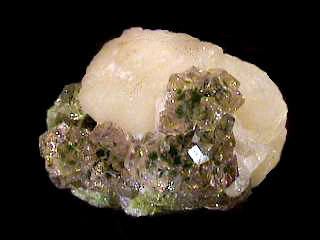
Figure 5: Several tiny but well-formed crystals of green chrome-bearing grossular embedded in a globular crystal of prehnite (white). Photo by Sylvain Roy.

Figure 6: Nice cubes of prehnite (up to 13 mm) on a diopside and albite matrix. This specimen was found in 2000. Photo by Sylvain Roy.
|
However, each year the mine has revealed beautiful surprises. A fine example was the summer of 1998 when I found magnificent pink garnets. In May 1999, I uncovered at the base of a rock containing rodhingite the lucky find of my life. In a brave attempt, with my two hands, 5 pound hammer and chisel, I picked through approximately 70 cm of very hard rock to uncover a massive diopside vein! When the vein was finally exposed (1 day later, after much hard work), I endeavoured to liberate a bare section of the vein using the heavy end of my small chisel. It was at this time that I had the surprise of my life. With only one blow, my chisel inserted 8 cm into the vein. By releasing a small piece of rock on top, I found myself staring at a dark hole – a mysterious cavity. But after removing a second piece of the vein the hole became large enough to allow daylight to enter. My heart at that point turned (three times and a half). I had uncovered an immense pocket of approximately 40 x 17 x 50 cm lined on the inside with splendid green diopside crystals! As if that were not enough, at the bottom of this pocket nature had produce exceptionally perfect gem-quality hessonite garnet crystals. The largest of these reached 1.4 cm in diameter, the whole crystal being impaled on diopside (Figures 7, 8 and 9).
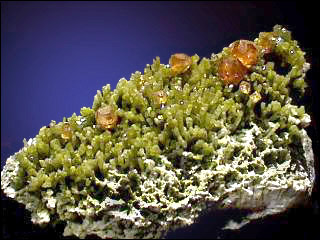
Figure 7: A cabinet-sized specimen (15 x 7.5 cm) consisting of 14 exceptional gemmy crystals of hessonite garnets on a diopside matrix. The largest hessonite crystal is 1.4 cm. Photo by Sylvain Roy.
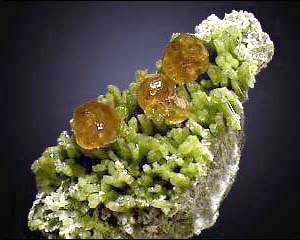
Figure 8: Another outstanding specimen I found in the pocket. This small cabinet-sized specimen has three gemmy hessonite garnets attached to a matrix of diopside crystals. The hessonites range from 12 to 14 mm in size. Photo by Sylvain Roy.
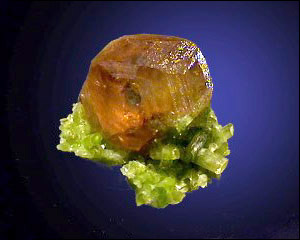
Figure 9: An aesthetic thumbnail specimen of hessonite garnet (up to 12 mm in diameter) attached to a diopside matrix. Photo by Sylvain Roy.
|
At the time of publication of this article, I will surely have made other excellent, lucky finds. If you are interested in learning more about or acquiring specimens from the Jeffrey mine, I invite you to visit my website, Sylvain's Gallery, or contact me by internet e-mail at roysminerals@videotron.ca.
Further Reading:
- G.E. Gregory. A visit to the Jeffrey Open Pit mine in Asbestos, Quebec, Canada. Rocks & Minerals (Sept.,Oct. 1980 Vol.55 #5) pp.214-216.
- J.D. Grice and R. Williams. Famous mineral localities: The Jeffrey Mine, Asbestos, Quebec. Mineralogical Record Vol. 10, No. 2 (April-March 1979), p. 69.
- F. Spertini. La Mine Jeffrey, Asbestos, Québec, Canada. Le Règne Minéral (Jan., Fév. 2001 #37) p.10-34.
Explore from Here:
- Sylvain's Gallery
http://www.chez.com/mineraldisplay
 Top of Page
Top of Page

Copyright © 2002 Sylvain Roy
E-mail: roysminerals@videotron.ca
Website: http://www.chez.com/mineraldisplay
This article may not be copied, distributed or reprinted in any form without the authors' permission. To contact the author, please use the e-mail address provided. If you are unable to contact the author, please contact the Canadian Rockhound. Authorized reprints must acknowledge the author and the Canadian Rockhound, and include the website URL address of the Canadian Rockhound.
The preceding article is a revised edition of an article that appeared in Mineral Webzine (Issue No. 8).
 More on Copyright
More on Copyright
Article Number: CR0206103
Roy, S. 2002. Hessonite garnets and other fine minerals from the Jeffrey Mine, Québec. Canadian Rockhound 6(1):3 [http://www.canadianrockhound.com]







